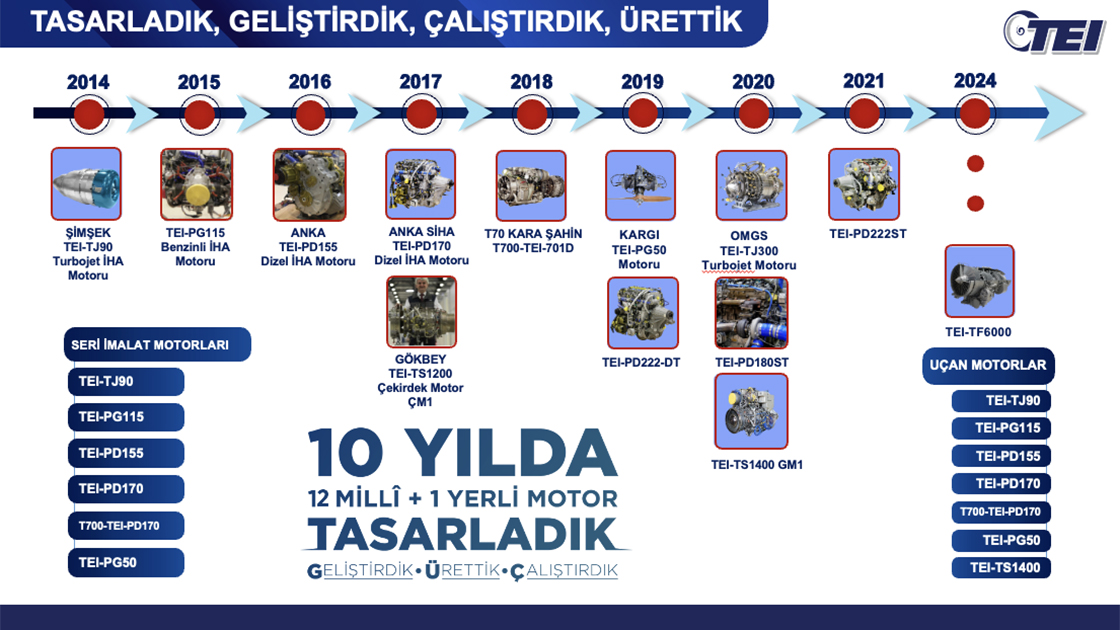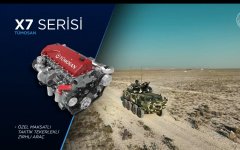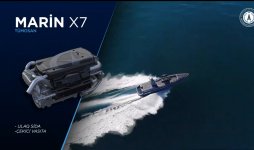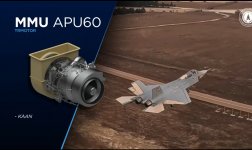You should not compare a first engine make of a company to its second make, it would take half the time. Also the fact that Kızılelma is uncrewed makes it acceptable to power it with an unproven engine. I would say it should take 2-3 new builds before TEI is confident that the engine will fly safely and with sufficient power which requires this much time.I hope so, in other way we rely on ukrainian Engines. When I see how long it took from first Test till tobserial Production for TS-1400, I become feel bad.
Latest Thread
You are using an out of date browser. It may not display this or other websites correctly.
You should upgrade or use an alternative browser.
You should upgrade or use an alternative browser.
TR Propulsion Systems
- Thread starter Combat-Master
- Start date
That's probably because the engine is not giving enough power to what kızılelma evolved into. So we have no clue why no more flights?Kizilelma hasn't been flying for quite a long time. Baykar has confirmed this as well.
This would make a lot of sense since the test bed will be mainly spared for sensor suite. There is a long way for sensor fusion and data link practices, Burfis and eots/irst/dircm tests. That plan shall not be bothered for engine tests, guess there is no time for mechanical integration. And as per Kaan engine, Kaan has got twin engine ready and likely can fly and land even if one fails.Possible. Baykar were already planning a twin-engine version of KE.
As a person interested in aerospace engineering, you should know better than me if that was the case, the issue stems from beginning of the project and does not say anything good about Baykar's capabilities. However, i know it is not the case so rest assured.That's probably because the engine is not giving enough power to what kızılelma evolved into. So we have no clue why no more flights?
You seemed to have caught something that I missed but apparently you didn't.As a person interested in aerospace engineering, you should know better than me if that was the case, the issue stems from beginning of the project and does not say anything good about Baykar's capabilities. However, i know it is not the case so rest assured.
I'm hoping Turkish Aerospace already designs for for 2+ engine Anka stealth bombers. Tf6000 will allow us to rapidly create new designs as we no longer need to make deals with other nations.
Mahmut Faruk Akşit is definitely my favorite burocrat in the Turkish defense industry ecosystem. In a short time, he has succeeded in producing modern engines at world standards.Let's also Thank Mahmut Faruk Akşit, who brought 11 domestic engines to Turkiye in 9 years.
Well, he isn't a bureaucrat in that sense.Mahmut Faruk Akşit is definitely my favorite burocrat in the Turkish defense industry ecosystem. In a short time, he has succeeded in producing modern engines at world standards.
When you have the base developed,the rest after that gets easier.I hope so, in other way we rely on ukrainian Engines. When I see how long it took from first Test till tobserial Production for TS-1400, I become feel bad.
2 years at most,probably 1 year.
TS-1400 is a civilian aero engine. Certification process is very slow 5 years at best. Military especially an unmanned aircraft engine can be operational almost immediately if TEI deems it's performance satisfactory.When you have the base developed,the rest after that gets easier.
2 years at most,probably 1 year.
Well there is still safety, you don't want it crashing near houses etc. Even without slow official certificationTS-1400 is a civilian aero engine. Certification process is very slow 5 years at best. Military especially an unmanned aircraft engine can be operational almost immediately if TEI deems it's performance satisfactory.
why ?Kizilelma hasn't been flying for quite a long time. Baykar has confirmed this as well.
They said they were doing wepaon integration, so no firing tests?why ?
I think @Windchime has more substantial infos than me. Unlike Türkiye the Korean gov releases next to nothing to the media about our classified ramjet, scramjet and turbofan engine projects.In one of his posts, @Windchime mentioned that SK has started testing their 5.5k lbf turbofan engine, iirc.
@Chocopie
2013 development start of low bypass military turbofan engine by Agency for Defense Development (ADD) and related national research institutes. At that time output goal was set at 5,500 lbf with Turbine Inlet Temperature (TIT) tech of 1350° C.
Assembly of core engine with high pressure compressor started in 2015. The only pic known to me of core engine and low-res technical slides:
In 2020 Hanwha Aerospace and Doosan Mottrol started assembly of the finished whole turbofan engine designs (in total 4 test units). According to development plans test engine 1 and 2 were powered on in 2023. Unit 3 and 4 will be tested this year until 2025. All with the same core engine but different parts/configs for front and after sections.
During development the steady rise of high temperature turbine material science of current TIT up to 1630° C: therefore Hanwha sets the output at 5,500-8,500 lbf.
From 2026 installation of flying engine in Kaori-X2 stealth UAV demonstrator to be flown in air.
Parallel project start in 2019 of 10,000 lbf turbofan engine without AB (high and low bypass version) until 2030s for high altitude unmanned reconnaissance & unmanned stealth fighter jets.
Parallel project start in 2023 of 15,000 lbf turbofan engine for manned fighter jets (22,000 lbf with AB) in F-414 class until ~2035. Estimated development time of 12-15 years with TIT of 1700° C and reachable output of 18,000 lbf dry thrust.
Last edited:

In line with its efforts to end Turkey's external dependence on engines, TEI developed 12 national and 1 domestic engine in a period of approximately 10 years. Flights were made with 7 of these engines, and mass production of 6 engines started.
TEI produced the TEI-TJ90 turbojet UAV engine for the high-speed target aircraft ŞİMŞEK in 2014, the TEI-PG115 gasoline UAV engine in 2015, the TEI-PD155 diesel UAV engine for ANKA in 2016, and the TEI-PD170 diesel for ANKA SİHA in 2017. It operated the TEI-TS1200 core engine for the UAV and GÖKBEY helicopter, the T700-TEI-701D for the T70 Black Hawk helicopter in 2018, the TEI-PG50 and also the TEI-PD222-DT engine for the kamikaze UAV KARGI in 2019.
In 2020, it managed to operate TEI-PD180ST and TEI-TS1400 engines, as well as the TEI-TJ300 engine, for medium-range anti-ship missiles, and TEI-PD222ST engines in 2021.
TEI last operated Turkey's first military turbofan engine, TEI-TF6000, in March 2024. TEI-TF6000, which will power the unmanned warplanes KIZILELMA and ANKA-III, will pave the way for the engine of the national combat aircraft KAAN.
TEI managed to fly with the platforms where these engines TEI-TJ90, TEI-PG115, TEI-PD155, TEI-PD170, T700-TEI-701D, TEI-PG50, TEI-TS1400 will be used.
Mass production started for TEI-TJ90, TEI-PG115, TEI-PD155, TEI-PD170, T700-TEI-701D, TEI-PG50 engines.
As a result of the work carried out to develop Turkey's first domestic and national aviation engine that will meet the power needs of medium-altitude long-endurance UAVs, especially ANKA, the TEI-PD170 turbodiesel aviation engine emerged.
TEI-PD170, which is ahead of its competitors in terms of altitude capabilities, weight and fuel consumption, has a ceiling altitude of 45 thousand feet.
TEI-PD170 engine, which has reached the mass production stage after 8000 hours of calibration and testing activities, has been integrated into ANKA and AKSUNGUR and is performing flight tests with Bayraktar TB3, which it carried into the sky for the first time.
TEI developed Turkey's first national helicopter engine TEI-TS1400 for the general purpose helicopter GÖKBEY. TEI has achieved many firsts in the fields of manufacturing and material technologies in the production of the engine with a power generation capacity of up to 1660 horsepower. The company, which produced the first single crystal turbine blade in Turkey, developed aviation quality forging technology for nickel and titanium alloys for the first time. TEI-TS1400, which made a successful flight test with the GÖKBEY helicopter, will start to power national helicopters after development, flight tests and mass production studies.
TEI-TJ90 Turbojet Engine, developed by TEI for target aircraft and producing 400 newtons of power, successfully completed its first flight with the Turkish Aerospace Industry's ŞİMŞEK platform in 2017.
Developed with the support of TÜBİTAK, TEI-PG50 is Turkey's first two-stroke aviation engine. The engine, produced for UAVs under 300 kilograms, draws attention with its 50 horsepower take-off power and 30 horsepower at an altitude of 16 thousand feet. The TEI-PG50 engine, which offers more power and a higher power/weight ratio than rival UAV engines used in its class, made its first flight in May 2019.
Turkey's first medium-range anti-ship missile engine, TEI-TJ300, was designed and produced with domestic and national resources. The engine, which weighs less than 30 kilograms and has a narrow diameter of 24 centimeters, is the first turbojet engine in the world that can produce 1300 newtons of thrust in its thrust class. TEI-TJ300 produces nearly 400 horsepower at speeds reaching 90 percent of the speed of sound
https://m5dergi.com/one-cikan/turk-savunma-sanayisi-10-yila-13-havacilik-motoru-sigdirdi/
Baykar will get the first TF-6000 by the end of 2025 for integration and testing if no major problems occur. This is the earliest possible date. Baykar will probably conduct tests for a year so the earliest serial production date for the TF-6000/10000 seems like 2027.
mavi batu milgem,I think its core engine for generators
x7 tümosan ÖMTTA projects
Marine x7
TR motor Apu/kaan
TR motor Alpu/hürjet
x7 tümosan ÖMTTA projects
Marine x7
TR motor Apu/kaan
TR motor Alpu/hürjet
Attachments
Last edited:
The engines that are integrated to the platforms / The engines that are in development












